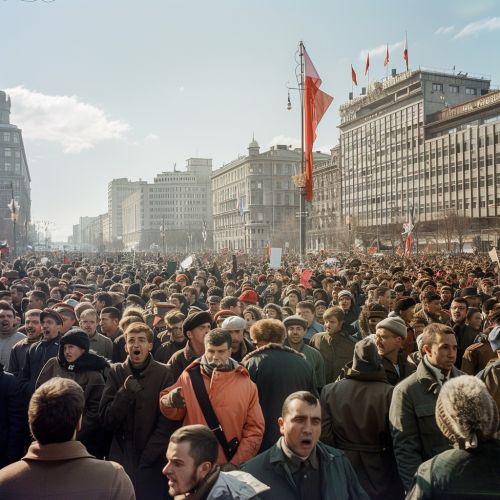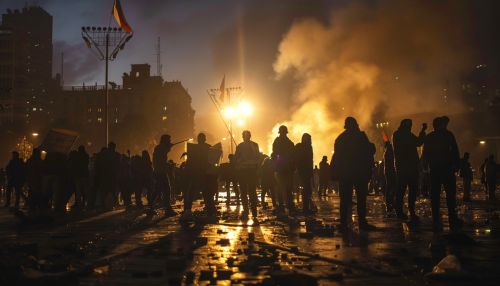Breakdown coup
Introduction
A breakdown coup refers to a specific type of coup d'état characterized by the collapse of existing governmental structures and the subsequent takeover by a new regime. Unlike traditional coups, which often involve a swift and decisive seizure of power by a small group, breakdown coups are marked by a prolonged period of instability and the disintegration of state institutions. This article delves into the intricate dynamics, historical contexts, and implications of breakdown coups, providing a comprehensive understanding of this complex phenomenon.
Characteristics of Breakdown Coups
Breakdown coups are distinguished by several key features:
- **Institutional Collapse**: The most defining characteristic is the collapse of existing governmental institutions. This can include the executive branch, legislature, judiciary, and various bureaucratic entities.
- **Prolonged Instability**: Unlike rapid coups, breakdown coups involve extended periods of political and social instability, often accompanied by civil unrest and economic turmoil.
- **Fragmented Power**: Power is often fragmented among various factions, including military, political, and sometimes paramilitary groups.
- **Public Disillusionment**: There is usually significant public disillusionment with the existing regime, which can manifest in widespread protests and loss of faith in governmental institutions.
Historical Contexts
Breakdown coups have occurred in various historical contexts, often in countries experiencing severe economic, social, and political crises. Some notable examples include:
- **The Russian Revolution of 1917**: The collapse of the Russian Empire and the subsequent Bolshevik takeover is a classic example of a breakdown coup. The disintegration of the Tsarist regime, combined with widespread discontent and the October Revolution, led to the establishment of Soviet rule.
- **The Iranian Revolution of 1979**: The overthrow of the Pahlavi dynasty and the establishment of the Islamic Republic of Iran involved the collapse of the Shah's regime and a prolonged period of revolutionary activity.
- **The Somali Civil War**: The collapse of the central government in Somalia in 1991 and the ensuing civil war is another example. The disintegration of state institutions led to a power vacuum filled by various warlords and factions.
Causes and Triggers
Several factors can contribute to the occurrence of a breakdown coup:
- **Economic Crisis**: Severe economic downturns, hyperinflation, and widespread poverty can erode the legitimacy of the existing regime and fuel public discontent.
- **Political Corruption**: High levels of corruption and nepotism can undermine trust in governmental institutions and create fertile ground for revolutionary movements.
- **Social Inequality**: Deep-seated social inequalities and injustices can lead to widespread dissatisfaction and calls for radical change.
- **External Interference**: Foreign intervention, whether through direct military action or covert operations, can destabilize a country and precipitate a breakdown coup.
Consequences
The consequences of a breakdown coup can be far-reaching and multifaceted:
- **Humanitarian Crisis**: The collapse of state institutions often leads to humanitarian crises, including mass displacement, food shortages, and widespread violence.
- **Economic Disruption**: The instability associated with breakdown coups can severely disrupt economic activities, leading to long-term economic decline.
- **Political Reconfiguration**: The aftermath of a breakdown coup often involves significant political reconfiguration, with new power structures and governance models emerging.
- **International Relations**: Breakdown coups can have profound implications for international relations, including shifts in alliances, changes in foreign policy, and impacts on regional stability.
Case Studies
The Russian Revolution of 1917
The Russian Revolution of 1917 is a seminal example of a breakdown coup. The disintegration of the Tsarist regime, exacerbated by the hardships of World War I, created a power vacuum that was filled by the Bolsheviks. The revolution involved a series of events, including the February Revolution, which led to the abdication of Tsar Nicholas II, and the October Revolution, which saw the Bolsheviks seize power. The subsequent civil war and the establishment of the Soviet Union marked a profound transformation in Russian society and governance.
The Iranian Revolution of 1979
The Iranian Revolution of 1979 resulted in the overthrow of the Pahlavi dynasty and the establishment of the Islamic Republic of Iran. The revolution was fueled by widespread dissatisfaction with the Shah's regime, characterized by political repression, economic inequality, and perceived cultural imperialism. The collapse of the Shah's government led to a period of intense revolutionary activity, culminating in the rise of Ayatollah Khomeini and the establishment of a theocratic state.
The Somali Civil War
The Somali Civil War, which began in 1991, is another example of a breakdown coup. The collapse of the central government led to a prolonged period of civil conflict, with various factions vying for control. The disintegration of state institutions resulted in a humanitarian crisis, with widespread displacement and violence. The war has had lasting impacts on Somalia's political landscape and continues to affect the region's stability.
Theoretical Perspectives
Several theoretical frameworks can be applied to understand breakdown coups:
- **State Failure Theory**: This theory posits that breakdown coups occur in the context of state failure, where the central government loses the ability to provide basic services and maintain order.
- **Revolutionary Theory**: Revolutionary theory examines the social, economic, and political conditions that lead to revolutionary movements and the overthrow of existing regimes.
- **Conflict Theory**: Conflict theory explores the role of social and economic inequalities in fueling conflicts and destabilizing governments.
Prevention and Mitigation
Preventing and mitigating breakdown coups involves addressing the underlying causes and implementing measures to stabilize and strengthen governmental institutions:
- **Economic Reforms**: Implementing economic reforms to address poverty, unemployment, and inequality can help reduce the risk of breakdown coups.
- **Anti-Corruption Measures**: Strengthening anti-corruption measures and promoting transparency can enhance public trust in governmental institutions.
- **Social Programs**: Investing in social programs to address inequalities and provide basic services can help mitigate social discontent.
- **International Support**: International support, including diplomatic efforts and economic aid, can play a crucial role in stabilizing countries at risk of breakdown coups.
Conclusion
Breakdown coups represent a complex and multifaceted phenomenon characterized by the collapse of existing governmental structures and prolonged periods of instability. Understanding the dynamics, causes, and consequences of breakdown coups is essential for developing strategies to prevent and mitigate their impacts. By addressing the underlying economic, social, and political factors, it is possible to reduce the risk of breakdown coups and promote stable and effective governance.


